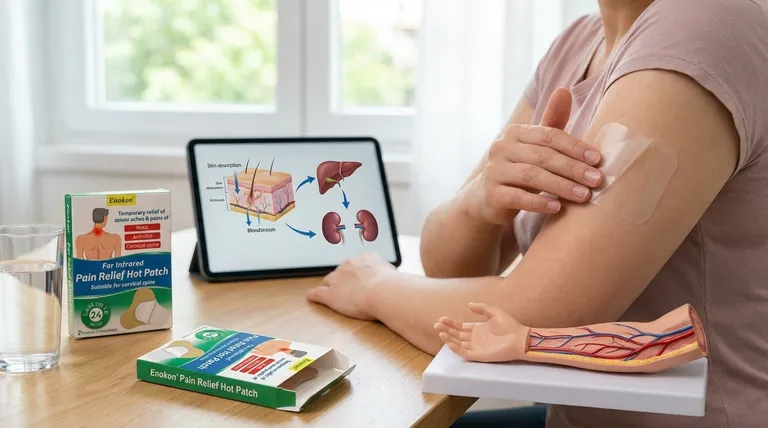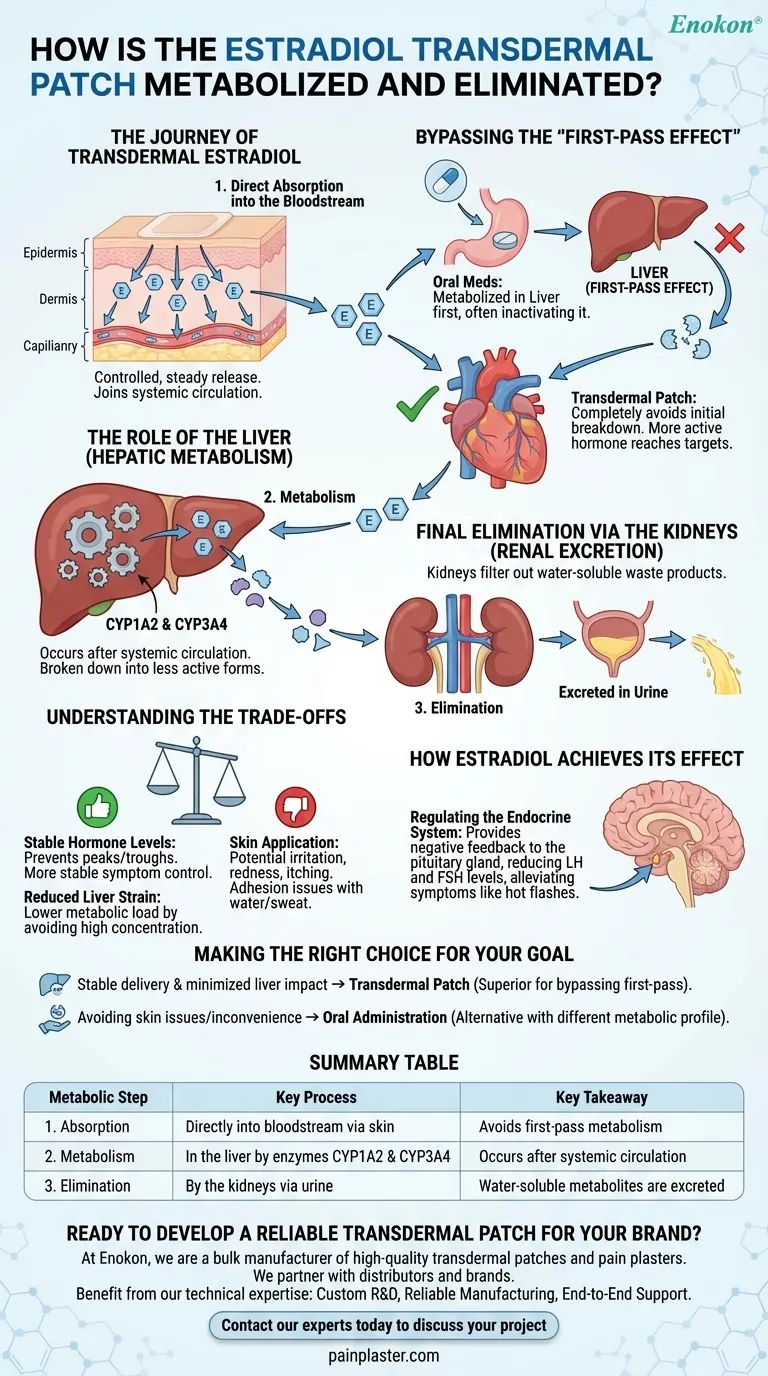For estradiol delivered via a transdermal patch, metabolism occurs primarily in the liver, driven by specific enzymes, after the hormone has already circulated through the body. The resulting byproducts are then filtered out of the blood and eliminated by the kidneys through urine.
The crucial distinction of the transdermal patch is that it delivers estradiol directly into the bloodstream, bypassing the digestive system and the liver's "first-pass effect." This allows for a more consistent and efficient delivery of the active hormone compared to oral administration.

The Journey of Transdermal Estradiol
Understanding the path estradiol takes from a patch is key to grasping its therapeutic advantages. The process is defined by how it enters the body, not just how it leaves.
Direct Absorption into the Bloodstream
The patch is designed to release estradiol at a controlled, steady rate. The hormone is absorbed through the layers of the skin and enters the small blood vessels (capillaries) directly beneath, joining the systemic circulation.
Bypassing the "First-Pass Effect"
When a medication is taken orally, it is absorbed from the gut and sent directly to the liver before it can circulate throughout the body. This is the first-pass effect, where the liver metabolizes a significant portion of the drug, often inactivating it.
The transdermal patch completely avoids this initial, intensive breakdown, ensuring more of the active hormone reaches its target tissues.
The Role of the Liver (Hepatic Metabolism)
Although the first pass is avoided, estradiol circulating in the blood will eventually pass through the liver. Here, it is metabolized (broken down) into less active forms.
This process is primarily handled by the cytochrome P450 enzyme system, specifically enzymes CYP1A2 and CYP3A4.
Final Elimination via the Kidneys (Renal Excretion)
Once the liver has converted the estradiol into its water-soluble metabolites, these byproducts are released back into the bloodstream. The kidneys then filter these waste products from the blood and excrete them from the body in urine.
Understanding the Trade-offs
The metabolic pathway of transdermal estradiol creates a distinct profile of advantages and disadvantages compared to other delivery methods.
Advantage: Stable Hormone Levels
The slow, continuous release from a patch prevents the sharp peaks and troughs in hormone levels often seen with daily oral pills. This consistency can lead to more stable symptom control.
Advantage: Reduced Liver Strain
By avoiding the high concentration of hormones that floods the liver after taking a pill, the transdermal patch places a lower metabolic load on the organ.
Disadvantage: Skin Application
The most common drawback is the potential for skin irritation, redness, or itching at the application site. Adhesion issues can also occur, particularly with water exposure or sweating.
How Estradiol Achieves its Effect
Once in circulation, estradiol works by modulating the pituitary gland's secretions of key reproductive hormones.
Regulating the Endocrine System
Estradiol provides negative feedback to the pituitary, reducing the elevated levels of gonadotropins—luteinizing hormone (LH) and follicle-stimulating hormone (FSH)—that are characteristic of postmenopausal states. This hormonal regulation is what helps alleviate symptoms like hot flashes.
Making the Right Choice for Your Goal
The choice between transdermal and oral estradiol hinges on your specific physiological needs and priorities.
- If your primary focus is stable hormone delivery and minimizing initial liver impact: The transdermal patch is often the superior method because it bypasses the first-pass effect entirely.
- If your primary focus is avoiding skin-related issues or the inconvenience of a patch: Oral administration is an alternative, but it comes with a different metabolic profile that must be considered with your healthcare provider.
Ultimately, understanding this metabolic journey empowers you to have a more informed discussion about which therapeutic approach is best suited to you.
Summary Table:
| Metabolic Step | Key Process | Key Takeaway |
|---|---|---|
| 1. Absorption | Directly into bloodstream via skin | Avoids first-pass metabolism |
| 2. Metabolism | In the liver by enzymes CYP1A2 & CYP3A4 | Occurs after systemic circulation |
| 3. Elimination | By the kidneys via urine | Water-soluble metabolites are excreted |
Ready to develop a reliable transdermal patch for your brand?
At Enokon, we are a bulk manufacturer of high-quality transdermal patches and pain plasters. We partner with healthcare and pharmaceutical distributors and brands to bring their products to market.
Benefit from our technical expertise:
- Custom R&D and Development: We tailor formulations to your specific API and delivery requirements.
- Reliable Manufacturing: Ensure consistent, controlled release and patient compliance.
- End-to-End Support: From concept to commercial-scale production.
Contact our experts today to discuss your transdermal patch project and discover how we can add value to your product line.
Visual Guide

Related Products
- Far Infrared Deep Heat Relief Patches Medicated Pain Relief Patches
- Prostate Pain Kidney Health Care Patch for Men
- Far Infrared Pain Patch Relief Pain Reliever for Back
- Far Infrared Knee Pain Patch Heat Patches for Pain Relief
- Far Infrared Heat Pain Relief Patches Transdermal Patches
People Also Ask
- How effective are pain relief patches for muscle pain? Target Localized Pain with Transdermal Delivery
- How do Deep Heat Pain Relief Patches provide pain relief? Discover the Drug-Free Mechanism
- How does the Deep Heat Back Patch work? A Drug-Free Solution for Targeted Pain Relief
- How quickly does the Deep Heat Pain Relief Back Patch activate and how long does it provide warmth? Get 16-Hour Relief
- How often should pain relief patches be used? Get the Right Schedule for Targeted Relief













